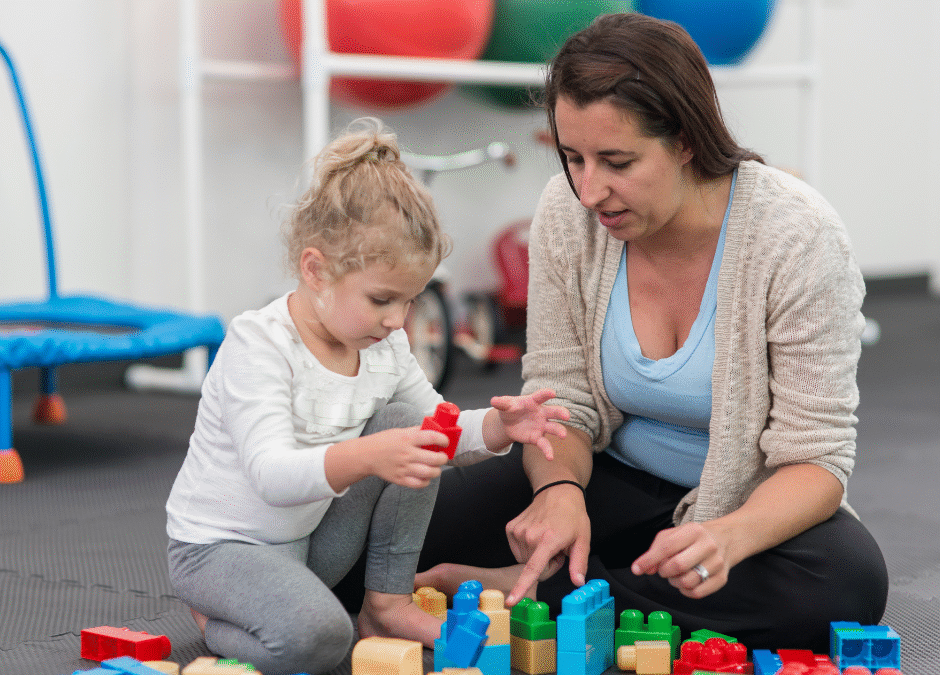In February of 2022, the CDC and American Academy of Pediatrics announced a new set of developmental milestones, the first in over 30 years. The old milestones were completely rewritten by a panel of experts.
But what do these changes mean for you and your child’s check-ups? Actually, they could mean a lot.
 Changing Percentiles
Changing Percentiles
The previous set of milestones stated when 50% of children could usually do a task. This means that if you were handed a checklist at a well-baby visit, the items on the list were things your typical baby may or may not be doing. It was not designed to screen babies who were behind, but more to inform parents of what typical development looked like.
The new checklist states things that 75% of babies and toddlers that age can do. This means that you really should be able to check “Yes, my baby can do this, ” for every milestone. If you cannot, that is cause for concern. Babies who do things in the lowest 25% often have developmental delays. A simple checklist can’t diagnose a delay, but it can point providers to children who need evaluation and services sooner. This way, children can get Early Intervention services sooner, which can help them get the skills they are struggling with.
Removing Confusing and Upsetting Language
One of the things these changes did was to remove wording or items that were confusing or not helpful. The older checklists sometimes had items several times, listed for different months with words like “is beginning to” or “is improving at.” These items were removed and more clear language was used so you as a parent can more easily say if your baby is doing something or not.
They also removed many items from the list that were called out as “warning signs.” Instead of calling out possible problems, those things were changed into milestones parents could check off that their babies could do. This makes the reason you are checking something off consistent. You check everything your baby can do, not some things they can do and some things that are concerns. It makes it more clear when your child has missed a milestone and makes it easier to discuss with your pediatrician any milestones your child cannot do. Missing milestones can be an early indicator of developmental delays, autism, and other challenges.
Crawling
 There were several milestones removed from the old list because they were researched and were deemed not good indicators of a delay. One of these milestones was crawling. Crawling can happen in babies anywhere from 6 months to 12 months, though more typically between ages 7 and 10 months. However, not all babies do learn to crawl or crawl typically. One of my children moved around with an army crawl, on his belly, for several months and only crawled on hands and knees briefly before walking. I know of another baby who mostly rolled to get where she wanted to go. And another child who scooted on her bum. All of these children learned to sit up and walk on a typical timeline and did not demonstrate signs of a delay.
There were several milestones removed from the old list because they were researched and were deemed not good indicators of a delay. One of these milestones was crawling. Crawling can happen in babies anywhere from 6 months to 12 months, though more typically between ages 7 and 10 months. However, not all babies do learn to crawl or crawl typically. One of my children moved around with an army crawl, on his belly, for several months and only crawled on hands and knees briefly before walking. I know of another baby who mostly rolled to get where she wanted to go. And another child who scooted on her bum. All of these children learned to sit up and walk on a typical timeline and did not demonstrate signs of a delay.
As an OT, I’m a fan of crawling. It is good to encourage your baby to crawl, even after they start to walk because it builds muscles and encourages brain integration because of the way it is a whole-body activity. But I understand why it didn’t meet the criteria for the new checklist. When and how your baby crawls is not a good way to decide if your baby needs physical therapy. A better indicator is if your baby can get themselves up to a seated position at 9 months and balance there. This indicates trunk control and strength, which babies need for crawling and walking. If you’ve never seen a baby get into a sitting position, it is a whole-body activity!
That is why “Gets to a sitting position by herself” is on the checklist for 9 months instead of crawling.
15 and 30 months
 There are now checklists for every age pediatricians typically have a well-child check-up. This means they have added checklists for 15 and 30-month-olds. As a fan of child development and screening for therapy, I’m a fan of these new checklists. Toddlers change daily, and these additional short checklists can help parents make sure their children are still on track.
There are now checklists for every age pediatricians typically have a well-child check-up. This means they have added checklists for 15 and 30-month-olds. As a fan of child development and screening for therapy, I’m a fan of these new checklists. Toddlers change daily, and these additional short checklists can help parents make sure their children are still on track.
There are several things on the 15-month checklist that 75% of babies this age can now do, that were on the old list for 12-month-olds, such as taking a few steps independently. It isn’t a problem if your baby hasn’t taken their first step on their first birthday, but if they still haven’t done it at 15 months, it may be time to see a physical therapist.
If you have reasons you don’t do as many well-child checkups as the list calls for, you can review the list yourself to check on your child’s progress. If your baby or toddler is not able to do some items for their age, make an appointment with your pediatrician to discuss further screenings, therapy, or early intervention.
Preschool and Beyond
 Looking at the new list of milestones, I was pleased to see that for ages 4 and 5, the new lists screen for things I’m concerned about as an occupational therapist and as a homeschooler.
Looking at the new list of milestones, I was pleased to see that for ages 4 and 5, the new lists screen for things I’m concerned about as an occupational therapist and as a homeschooler.
If your 4-year-old cannot do these tasks from the list, it is time to see an occupational therapist. One of my children struggled with these, and while I eventually did put her in OT with someone else (no, she would not do it for mom), I wish I had started her in OT sooner than I did. I hope that doctors recognize that children who can’t do these skills should see an OT.
- Draws a person with three or more body parts
- Catches a large ball most of the time
- Serves himself food or pours water, with adult supervision
- Unbuttons some buttons
- Holds crayon or pencil between fingers and thumb (not a fist)
And on the age 5 list, there are a few additions to screen children for dyslexia and learning disabilities. The sooner a child with dyslexia can begin getting individualized systematic reading instruction the more likely they are to be able to read on grade level.
- Names some numbers between 1 and 5 when you point to them
- Uses or recognizes simple rhymes (bat-cat, ball-tall)
- Uses words about time, like “yesterday,” “tomorrow,” “morning, ” or “night”
- Pays attention for 5 to 10 minutes during activities. For example, during storytime or making arts and crafts (screen time does not count)
- Writes some letters in her name
- Names some letters when you point to them
Checking For Yourself
If you would like to check on your child’s progress, you can view all the checklists on the CDC website. They also offer an App for tracking your child’s development. Please note, that not every important skill for a child to learn is on this list. If you feel something is wrong, even if your child is hitting their milestones, talk to your pediatrician.

 Changing Percentiles
Changing Percentiles



0 Comments